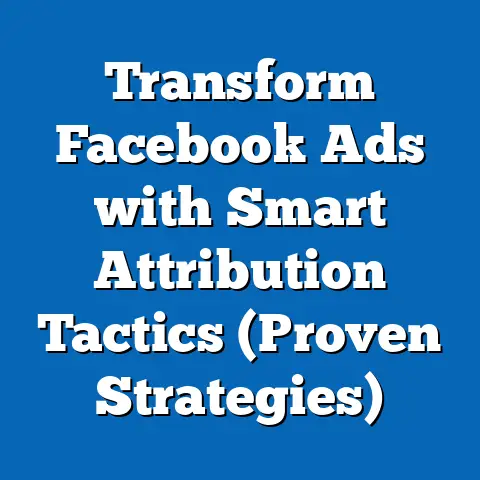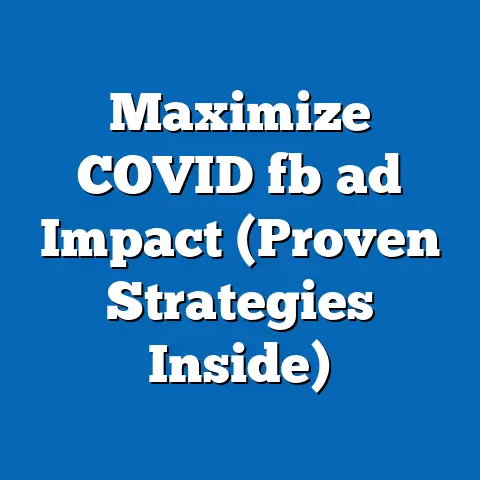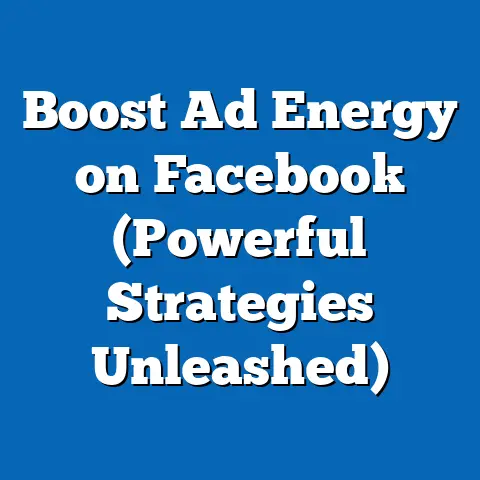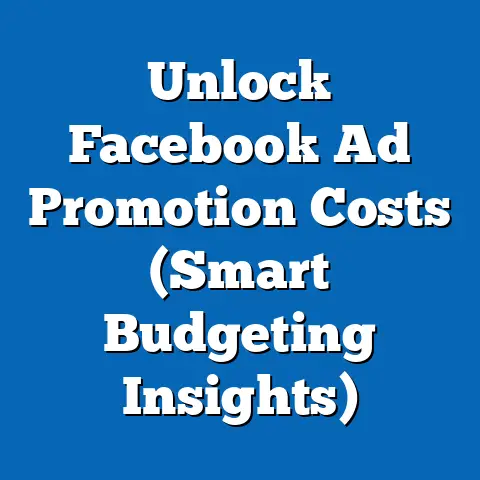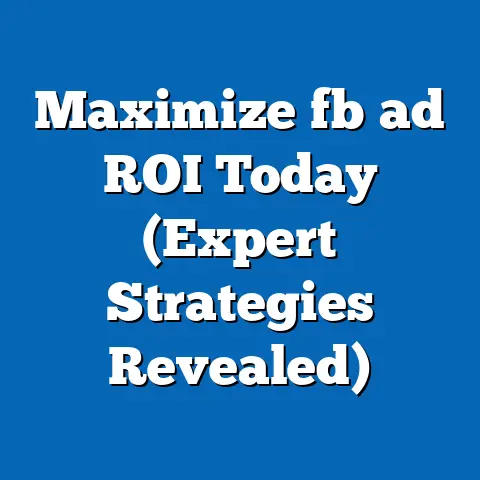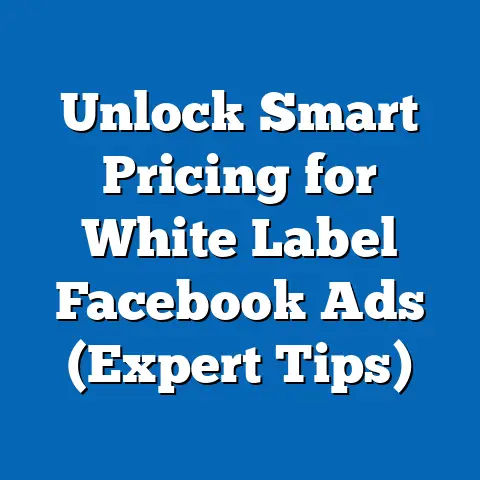Unlocking Facebook’s 2025 Ad Revenue Potential (Future Insights)
I remember the first time I ever touched Facebook Ads Manager. It was back in 2012, and I was running a small campaign for a local bakery. I was so excited! I envisioned lines out the door, overflowing with customers clamoring for croissants and cookies, all thanks to my brilliant Facebook ad campaign. The reality? Well, let’s just say my targeting was… less than precise. I think I ended up showing ads for sourdough bread to a group of college students who were primarily interested in late-night pizza. It was a humbling, yet hilarious, experience. That initial foray into Facebook advertising was a chaotic blend of excitement, confusion, and ultimately, a lot of wasted budget. But it sparked a curiosity that has driven me to explore the platform’s potential ever since.
Fast forward to today, and the world of Facebook advertising is almost unrecognizable. The platform has evolved at breakneck speed, incorporating sophisticated targeting options, advanced analytics, and a constantly shifting landscape of best practices. Looking ahead to 2025, Facebook is poised to remain a powerful force in the digital marketing world, but the strategies for unlocking its ad revenue potential will demand a new level of sophistication and adaptability. In this article, I’ll delve into the current state of Facebook advertising, predict the trends that will shape its future, and provide actionable strategies to help you capitalize on the platform’s evolving landscape.
Current State of Facebook Advertising
As of 2023, Facebook remains a dominant player in the digital advertising arena. With billions of monthly active users, it offers an unparalleled opportunity for businesses of all sizes to reach a massive and diverse audience. According to Statista, Facebook’s advertising revenue reached over $116 billion in 2022, demonstrating its continued importance for marketers worldwide.
The platform offers a wide range of ad formats, each designed to engage users in different ways. Image ads are still a staple, offering a simple and visually appealing way to capture attention. Video ads have become increasingly popular, leveraging the power of motion and sound to tell stories and connect with audiences on a deeper level. Carousel ads allow businesses to showcase multiple products or features in a single ad unit, making them ideal for e-commerce brands. And of course, Stories ads provide an immersive and ephemeral way to connect with users in a more personal and authentic way.
Underpinning all of these ad formats is Facebook’s powerful algorithm, which uses data analytics to shape ad targeting and performance. The algorithm analyzes vast amounts of user data, including demographics, interests, behaviors, and connections, to identify the most relevant audiences for each ad. This allows advertisers to target their campaigns with incredible precision, ensuring that their message reaches the people who are most likely to be interested in their products or services. The constant evolution of this algorithm means advertisers need to stay agile and continuously optimize their campaigns.
Key Takeaway: Facebook remains a powerhouse in digital advertising, with a diverse range of ad formats and a sophisticated algorithm that enables precise targeting. To succeed, businesses need to understand the current landscape and adapt their strategies accordingly.
Predicted Trends Leading to 2025
Looking ahead to 2025, several key trends are poised to significantly influence Facebook’s ad revenue potential.
The Rise of AI and Machine Learning
Artificial intelligence (AI) and machine learning (ML) are already playing a significant role in Facebook advertising, and their influence will only continue to grow in the coming years. AI-powered tools are being used to automate ad creation, optimize bidding strategies, and personalize ad experiences. For example, Facebook’s Advantage+ campaign budget allows the algorithm to dynamically allocate your budget across ad sets to maximize performance. This level of automation frees up marketers to focus on higher-level strategic thinking.
By 2025, I expect to see even more sophisticated AI-driven solutions that can predict user behavior with greater accuracy and deliver hyper-personalized ads that resonate with individual users on a deeper level. This will not only improve ad performance but also enhance the overall user experience, making Facebook advertising more effective and less intrusive.
Increasing Mobile Usage
Mobile devices are already the primary way that most people access Facebook, and this trend will continue to accelerate in the coming years. As mobile devices become more powerful and ubiquitous, users will spend even more time engaging with content and interacting with brands on the go. This means that mobile-first ad formats, such as video ads, Stories ads, and in-stream video ads, will become even more important for advertisers looking to capture attention and drive results.
To capitalize on this trend, businesses need to ensure that their ads are optimized for mobile devices, with engaging visuals, concise messaging, and clear calls to action. They also need to consider the context in which users are viewing their ads, such as while commuting, waiting in line, or browsing social media during their free time.
The Growing Importance of Privacy and Data Protection
In recent years, there has been a growing awareness of privacy and data protection among consumers, and governments around the world are responding with stricter regulations, such as the General Data Protection Regulation (GDPR) in Europe and the California Consumer Privacy Act (CCPA) in the United States. These regulations are forcing Facebook and other digital platforms to give users more control over their data and to be more transparent about how their data is being used.
By 2025, I expect to see even more stringent privacy regulations, which will likely have a significant impact on Facebook advertising. Advertisers will need to adapt their strategies to comply with these regulations, focusing on building trust with users and obtaining explicit consent for data collection. They will also need to explore alternative targeting methods that rely less on personal data, such as contextual targeting and interest-based targeting.
E-commerce Integration Within Facebook
Facebook has been steadily expanding its e-commerce capabilities in recent years, with the introduction of features like Facebook Shops and Instagram Shopping. These features allow businesses to sell products directly to consumers within the Facebook ecosystem, creating a seamless and convenient shopping experience.
By 2025, I expect to see even deeper integration of e-commerce within Facebook, with new features and tools that make it even easier for businesses to sell products and for consumers to discover and purchase them. This will create new opportunities for advertisers to drive sales and revenue, particularly for e-commerce brands. For example, dynamic product ads, which automatically showcase relevant products to users based on their browsing history, will become even more effective.
Key Takeaway: Facebook’s future ad revenue potential hinges on adapting to the rise of AI, increasing mobile usage, stricter privacy regulations, and deeper e-commerce integration. Businesses that can navigate these trends effectively will be well-positioned to succeed.
Case Studies and Success Stories
To illustrate the power of Facebook advertising, let’s take a look at a few compelling case studies:
Tech Startup: Leveraging Video Ads for Brand Awareness
A tech startup specializing in AI-powered productivity tools wanted to increase brand awareness and generate leads. They created a series of engaging video ads showcasing the key features and benefits of their product. By targeting professionals in specific industries with an interest in technology and productivity, they were able to reach a highly relevant audience.
The results were impressive: a 300% increase in website traffic, a 200% increase in leads, and a significant boost in brand awareness. The video ads not only captured attention but also effectively communicated the value proposition of the product.
Local Restaurant: Driving Foot Traffic with Targeted Offers
A local restaurant wanted to drive foot traffic and increase sales. They created a series of targeted Facebook ads offering discounts and promotions on specific menu items. By targeting users within a specific radius of the restaurant with an interest in food and dining, they were able to reach a highly localized audience.
The results were equally impressive: a 40% increase in foot traffic, a 25% increase in sales, and a significant boost in customer engagement. The targeted offers not only incentivized users to visit the restaurant but also helped to build brand loyalty.
Non-profit Organization: Raising Awareness and Donations
A non-profit organization wanted to raise awareness and donations for their cause. They created a series of emotional and compelling Facebook ads highlighting the impact of their work. By targeting users with an interest in social causes and philanthropy, they were able to reach a highly receptive audience.
The results were remarkable: a 500% increase in website traffic, a 300% increase in donations, and a significant boost in brand awareness. The emotional ads not only resonated with users but also inspired them to take action and support the organization’s mission.
Key Takeaway: These case studies demonstrate the versatility of Facebook advertising and its ability to drive results for businesses of all sizes and across various industries. By understanding their target audience, crafting compelling ads, and leveraging the platform’s targeting capabilities, businesses can achieve significant success with Facebook advertising.
Challenges and Opportunities
As Facebook evolves towards 2025, advertisers will face a number of challenges and opportunities.
Challenges
-
Increased Competition for Ad Space: As more businesses flock to Facebook advertising, the competition for ad space will inevitably increase, driving up ad costs and making it more difficult to stand out from the crowd.
-
Ad Fatigue Among Users: As users are bombarded with more and more ads, they may become fatigued and less receptive to advertising messages. This can lead to lower click-through rates and conversion rates.
-
Navigating the Balance Between Personalization and Privacy: As privacy regulations become stricter, advertisers will need to find a way to balance personalization with privacy, ensuring that they are delivering relevant ads without violating user privacy.
Increased Competition for Ad Space: As more businesses flock to Facebook advertising, the competition for ad space will inevitably increase, driving up ad costs and making it more difficult to stand out from the crowd.
Ad Fatigue Among Users: As users are bombarded with more and more ads, they may become fatigued and less receptive to advertising messages. This can lead to lower click-through rates and conversion rates.
Navigating the Balance Between Personalization and Privacy: As privacy regulations become stricter, advertisers will need to find a way to balance personalization with privacy, ensuring that they are delivering relevant ads without violating user privacy.
Opportunities
-
Leveraging New Tools and Features: Facebook is constantly introducing new tools and features that can help advertisers improve their campaigns. By staying informed about these updates and leveraging them effectively, businesses can gain a competitive edge.
-
Building Community Engagement: By focusing on building community engagement and fostering authentic interactions with users, businesses can create a loyal following that is more receptive to their advertising messages.
-
Experimenting with New Ad Formats: Facebook offers a wide range of ad formats, and businesses should experiment with different formats to see what works best for their target audience.
-
Utilizing Advanced Targeting Options: Facebook’s advanced targeting options allow businesses to reach a highly relevant audience. By leveraging these options effectively, businesses can improve their ad performance and drive better results.
Leveraging New Tools and Features: Facebook is constantly introducing new tools and features that can help advertisers improve their campaigns. By staying informed about these updates and leveraging them effectively, businesses can gain a competitive edge.
Building Community Engagement: By focusing on building community engagement and fostering authentic interactions with users, businesses can create a loyal following that is more receptive to their advertising messages.
Experimenting with New Ad Formats: Facebook offers a wide range of ad formats, and businesses should experiment with different formats to see what works best for their target audience.
Utilizing Advanced Targeting Options: Facebook’s advanced targeting options allow businesses to reach a highly relevant audience. By leveraging these options effectively, businesses can improve their ad performance and drive better results.
Key Takeaway: While challenges exist, the opportunities for success in Facebook advertising remain significant. By adapting to the changing landscape, businesses can overcome these challenges and capitalize on the platform’s evolving capabilities.
Strategies for Capitalizing on Future Trends
To maximize your return on ad spend by 2025, consider these actionable strategies:
Utilize Advanced Targeting Options and Analytics Tools
Deeply understand and leverage Facebook’s advanced targeting options to reach your ideal audience. Use custom audiences, lookalike audiences, and detailed targeting to refine your reach. Pair this with robust analytics tools to track performance metrics and gain insights into user behavior. For example, I often use Facebook Pixel data to retarget website visitors with personalized ads, significantly improving conversion rates.
Experiment with New Ad Formats and Placements
Don’t be afraid to experiment with new ad formats and placements, such as Reels ads, in-stream video ads, and augmented reality (AR) ads. These formats can be highly engaging and can help you capture attention in a crowded marketplace. I remember when I first started using Stories ads; they felt so much more personal and authentic, and my engagement rates skyrocketed!
Build Community Engagement and Brand Loyalty
Focus on building community engagement and fostering authentic interactions with users. Respond to comments and messages, create engaging content that encourages participation, and run contests and giveaways. This will help you build a loyal following that is more receptive to your advertising messages. I always tell my clients: your Facebook page isn’t just an advertising platform; it’s a community hub.
Stay Informed About Platform Updates and Shifts in User Behavior
Facebook is constantly evolving, so it’s essential to stay informed about platform updates and shifts in user behavior. Follow industry blogs, attend webinars, and join online communities to stay up-to-date on the latest trends. I personally subscribe to several newsletters and actively participate in Facebook advertising forums to stay ahead of the curve.
Key Takeaway: By implementing these strategies, businesses can position themselves for success in the evolving landscape of Facebook advertising and maximize their return on ad spend.
Conclusion
As we look towards 2025, Facebook’s ad revenue potential remains immense, but unlocking that potential will require a new level of sophistication and adaptability. By understanding the current state of Facebook advertising, predicting the trends that will shape its future, and implementing actionable strategies to capitalize on those trends, businesses can position themselves for success in the years to come.
Remember my early days of targeting college students with sourdough bread ads? I’ve learned a lot since then. The key to success on Facebook, now and in the future, is to stay curious, keep experimenting, and never stop learning.
So, take a moment to reflect on your own advertising strategies. How are you preparing for the future of Facebook ads? What steps can you take today to ensure that you are ready to capitalize on the platform’s evolving landscape? The future of Facebook advertising is bright, and I encourage you to embrace the challenges and opportunities that lie ahead. The time to act is now.

